By Shigeru Mizuki. Released in Japan as “Comic Shouwashi” by Kodansha. Released in North America by Drawn & Quarterly.
The one thing that will strike you as you read this manga history of Japan by one of its preeminent creators is how it should not remotely work the way that it does. This book is over 500 pages, and a great deal of it is simply laying out the facts – they’re about 2/3 of the book, with the other third devoted to Mizuki’s own autobiography. It should be dry, didactic and boring. And yet it’s utterly compelling. Partly this is simply due to what’s going on – this is a dark and chilling time in Japanese history, and the facts really don’t need embellishment or excitement, as presented by themselves they can carry a book. But partly this is due to the fact that Mizuki isn’t just famous because he talked about a lot of yokai – he is a genius craftsman, writing a cyclical narrative where we constantly spiral back to see what’s happening in the most concise way possible.
The narrative starts out as third-person omniscient, but Mizuki quickly comes to realize that an actual character voice is needed to help explain some of what’s going on. (He also does this via conversations between two people on the issues of the day, many of which point out how much of a narrative device this is. “Let me tell you about this.” “I know about it already, but tell me anyway.) As a result, Nezumi Otoko from Gegege No Kitaro insinuates himself into this narrative, so quietly that it takes a good 20 pages before he has to introduce himself. As D&Q point out in their endnotes, not only does this allow any children reading to get their narrative from a beloved character, but Nezumi Otoko is essentially untrustworthy, shifty, and always out for himself. Thus the narrative voice is skewed so that we aren’t meant to be quite as trusting of the facts as we would be if it were still Mizuki narrating. (He also gets in a few slaps, which pleased me.)
We also, as I noted, get the story of Shigeru Mizuki growing up during Showa, which provides relief from the historical facts. Some of this narrative will be familiar to those who’ve read Nonnonba, but this continues beyond that, and the yokai that appear here are few and fleeting. What struck me most about Mizuki’s story is how harshly critical he seems to be of his boyhood self. We’re presented with a young boy who goes off to do his own thing, doesn’t like school, gets involved in gangs, and by the end of the volume seems to be unfit for even the smallest and most menial jobs. His artistic talent is mentioned, but it’s described as sort of a side hobby that interferes with his ongoing life. This is not a likeable Mizuki, and it’s a striking choice.
Then again, it also fits with the bleak narrative as a whole. Growing up in the period covered here in this book meant knowing poverty, and hunger, and endless fatigue. It meant repression, and being imprisoned or executed for having the wrong views. It meant a military buildup that seemed to happen without the permission of any of the government, and reading about assassinations and murders seemingly every day. Mizuki needed to include the scenes with his family, as even if they are bleak, they still remind us that there are still good people at heart in the country, even as they get swept up in a tide of nationalistic fury. By the time the book ends, Tojo is making speeches, and Mizuki notes that he “is a man who never smiles, and because of that he takes away the smiles of the Japanese people.” This is almost a cliffhanger ending, leading into the events of the 2nd World War that will be covered in 1939-1944, due out this spring.
Make no mistake, this book can be very dry and factual. And yet there was no time when I ever felt the need to put it down and do something else. Reality makes for the best stories, even if they can be scary and oppressive. This book shows once again why Mizuki is one of the best creators in all of Japan. Highly recommended.
